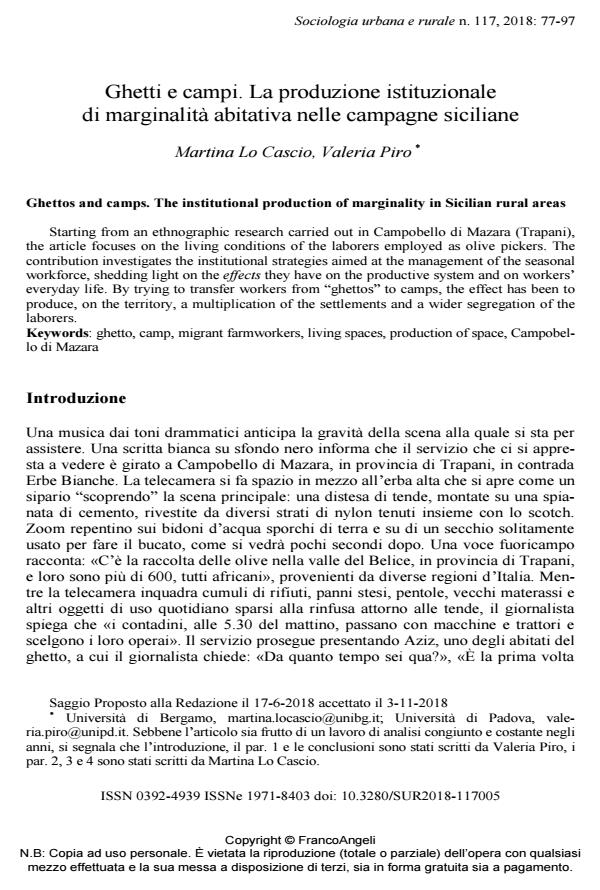Ghettos and camps. The institutional production of marginality in Sicilian rural areas
Journal title SOCIOLOGIA URBANA E RURALE
Author/s Martina Lo Cascio, Valeria Piro
Publishing Year 2019 Issue 2018/117
Language Italian Pages 21 P. 77-97 File size 304 KB
DOI 10.3280/SUR2018-117005
DOI is like a bar code for intellectual property: to have more infomation
click here
Below, you can see the article first page
If you want to buy this article in PDF format, you can do it, following the instructions to buy download credits

FrancoAngeli is member of Publishers International Linking Association, Inc (PILA), a not-for-profit association which run the CrossRef service enabling links to and from online scholarly content.
Starting from an ethnographic research carried out in Campobello di Mazara (Trapani), the article focuses on the living conditions of the laborers employed as olive pickers. The contribution investigates the institutional strategies aimed at the management of the seasonal workforce, shedding light on the effects they have on the productive system and on workers’ everyday life. By trying to transfer workers from "ghettos" to camps, the effect has been to produce, on the territory, a multiplication of the settlements and a wider segregation of the laborers.
Keywords: Ghetto, camp, migrant farmworkers, living spaces, production of space, Campobello di Mazara
- ‘We welcome migrants and the tourists come’: postmodern hospitality in Palermo, Sicily Margaret Neil, in Journal of the Royal Anthropological Institute /2024 pp.537
DOI: 10.1111/1467-9655.14093 - Producing labour stratification: how migration policies affect the working, living and housing conditions of migrant farmworkers Giuliana Sanò, in Identities /2025 pp.844
DOI: 10.1080/1070289X.2024.2373618 - Contested Appropriations: Informal Migrant Settlements as Ambiguous Spaces Beyond Temporal Borders Sebastian Benedikt, in Journal of International Migration and Integration /2024 pp.1105
DOI: 10.1007/s12134-023-01112-x - The eternal return of normality Giuliana Sanò, in Anuac /2022 pp.151
DOI: 10.7340/anuac2239-625X-4930 - Caporalato e ingresso della manodopera straniera nell'agricoltura del Mezzogiorno. L'elaborazione pubblica e istituzionale della questione tra anni Settanta e Novanta Donato Di Sanzo, in ITALIA CONTEMPORANEA 306/2024 pp.42
DOI: 10.3280/IC2024-306003
Martina Lo Cascio, Valeria Piro, Ghetti e campi. La produzione istituzionale di marginalità abitativa nelle campagne siciliane in "SOCIOLOGIA URBANA E RURALE" 117/2018, pp 77-97, DOI: 10.3280/SUR2018-117005